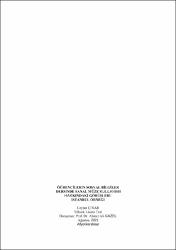Öğrencilerin sosyal bilgiler dersinde sanal müze kullanımı hakkındaki görüşleri: İstanbul örneği
Özet
Bu çalışma öğrencilerin Sosyal Bilgiler dersinde sanal müze kullanımı hakkında görüşlerini belirlemek amacıyla nitel araştırma yöntemlerinden fenomoloji desenine göre hazırlanmıştır. Çalışma 2020-2021 eğitim öğretim yılının 2. yarıyılında İstanbul ili Arnavutköy ilçesinde bulunan bir ortaokulda 7. sınıfta öğrenim gören 100 öğrenci ile sınırlıdır. Çalışmada öğrencilere ilk olarak ‘Kurtuluş Savaşı Müzesi’ ve ‘Cumhuriyet Müzesi’ sanal olarak gezdirilmiştir. Öğrencilerin sanal müzeleri bilinçli bir şekilde gezebilmeleri için 2 etkinlik yaprağı dağıtılmış ve verilen görevleri yapmaları istenmiştir. Etkinlik sonrası öğrencilere, araştırmacı tarafından hazırlanan açık uçlu sorulardan oluşan anket formu dağıtılmış ve düşünceleri alınmıştır. Öğrencilerin anket sorularına verdikleri cevaplar betimsel analiz yöntemi ile çözümlenmiştir. Verilerin analizi sonucunda çalışmaya katılan öğrenciler, gerçek müze gezilerini müze atmosferini yansıtmaması, eserlere dokunulamaması, eserlerin canlı görülememesi gibi nedenlerden dolayı sanal müze gezilerine tercih etmişlerdir. Fakat sanal müze uygulamasının müzeye ulaşımda birçok engeli ortadan kaldırdığı için derslerde kullanımının Sosyal Bilgiler dersini öğrenmelerine katkı sağlayacağını belirtmişlerdir. Sonuç olarak anket sorularına verilen cevaplara göre öğrenciler sanal müze gezilerinin Sosyal Bilgiler dersini öğrenmelerini kolaylaştırdığını ve derslerine fayda sağladığını ifade etmişlerdir. This study was prepared according to the phenomenology design, which is one of the qualitative research methods, in order to determine the opinions of the students about the use of virtual museums in the Social Studies course. The study is limited to 100 students studying in the 7th grade of a secondary school in Arnavutköy district of Istanbul in the 2nd semester of the 2020-2021 academic year. In the study, the students were first given a virtual tour of the 'Liberation War Museum' and the 'Republican Museum'. In order for the students to visit the virtual museums consciously, 2 activity sheets were distributed and they were asked to complete the given tasks. After the activity, a questionnaire consisting of open-ended questions prepared by the researcher was distributed to the students and their opinions were taken. The answers given by the students to the survey questions were analyzed by descriptive analysis method. As a result of the analysis of the data, the students who participated in the study preferred real museum tours to virtual museum tours for reasons such as not reflecting the museum atmosphere, not touching the artifacts, and not seeing the artifacts live. However, they stated that since the virtual museum application eliminates many obstacles in reaching the museum, its use in the lessons will contribute to their learning of the Social Studies course. As a result, according to the answers given to the survey questions, the students stated that virtual museum tours facilitated their learning in the Social Studies course and benefited their lessons.
Bağlantı
https://hdl.handle.net/11630/9826Koleksiyonlar
- Yüksek Lisans Tezleri [1691]



















